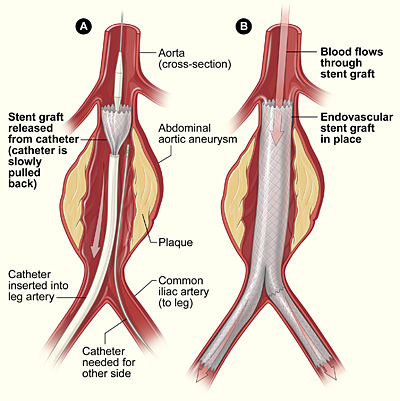How Is an Aneurysm Treated?
Goals of Treatment
Some aneurysms, mainly small ones that are not
causing pain, can be treated with "watchful waiting." Others need to be treated
to prevent growth and complications. The goals of treatment are to prevent the
aneurysm from growing, prevent or reverse damage to other body structures,
prevent or treat a rupture, and to allow you to continue to participate in
normal daily activities.
Treatment Options
Medicine and surgery are the two types of treatment
for an aneurysm. Medicines may be prescribed before surgery or instead of
surgery. Medicines are used to reduce pressure, relax blood vessels, and reduce
the risk of rupture. Beta blockers and calcium channel blockers are the
medicines most commonly used.
Surgery may be recommended if an aneurysm is large
and likely to rupture.
Treatment by Type of Aneurysm
Aortic Aneurysm
Experts recommend that men who have ever smoked (at
least 100 cigarettes in their lifetime) and are between the ages of 65 and 75
should have an
ultrasound screening to check for abdominal aortic
aneurysms.
Treatment recommendations for aortic aneurysms are
based on the size of the aneurysm. Small aneurysms found early can be treated
with "watchful waiting."
- If the diameter of the aorta is small-less than 3
centimeters (cm)-and there are no symptoms, "watchful waiting" and a followup
screening in 5 to 10 years may be all that is needed, as determined by the
doctor.
- If the aorta is between 3 and 4 cm in diameter,
the patient should return to the doctor every year for an ultrasound to see if
the aneurysm has grown.
- If the aorta is between 4 and 4.5 cm, testing
should be repeated every 6 months.
- If the aorta is larger than 5 cm (2 inches around
or about the size of a lemon) or growing more than 1 cm per year, surgery
should be considered as soon as possible.
Two main types of surgery to repair aortic aneurysms
are open abdominal or open chest repair and endovascular repair.
The traditional and most common type of surgery for
aortic aneurysms is open abdominal or open chest repair. It involves a major
incision in the abdomen or chest. General anesthesia is needed with this
procedure.
The aneurysm is removed and the section of aorta is
replaced with an artificial graft made of material such as Dacron® or
Teflon®. The surgery takes 3 to 6 hours, and the patient remains in the
hospital for 5 to 8 days. It often takes a month to recover from open abdominal
or open chest surgery and return to full activity. Open abdominal and chest
surgeries have been performed for 50 years. More than 90 percent of patients
make a full recovery.
In endovascular repair, the aneurysm is not removed,
but a graft is inserted into the aorta to strengthen it. This type of surgery
is performed through catheters (tubes) inserted into the arteries; it does not
require surgically opening the chest or abdomen.
To perform endovascular repair, the doctor first
inserts a catheter into an artery in the groin (upper thigh) and threads it up
to the area of the aneurysm. Then, watching on
x ray, the surgeon threads the graft (also called a stent
graft) into the aorta to the aneurysm. The graft is then expanded inside the
aorta and fastened in place to form a stable channel for blood flow. The graft
reinforces the weakened section of the aorta to prevent the aneurysm from
rupturing.

The illustration shows the placement
of an endovascular stent graft in an aortic aneurysm. In figure A, a catheter
is inserted into an artery in the groin (upper thigh). It is then threaded up
to the abdominal aorta, and the stent graft is released from the catheter. In
figure B, the stent graft allows blood to flow through the aneurysm.
Endovascular repair surgery reduces recovery time to
a few days and greatly reduces time in the hospital. The procedure has been
used since 1999. Not all aortic aneurysms can be repaired with this procedure.
The exact location or size of the aneurysm may prevent the stent graft from
being safely or reliably positioned inside the aneurysm.
Cerebral Aneurysm
Treatment for cerebral (brain) aneurysms depends on
the size and location of the aneurysm, whether it is infected, and whether it
has ruptured. A small cerebral aneurysm that hasn't burst may not need
treatment. A large cerebral aneurysm may press against brain tissue, causing a
severe headache or impaired vision, and is likely to burst. If the aneurysm
ruptures, there will be bleeding into the brain which will cause a
stroke. If a cerebral aneurysm becomes infected, it requires
immediate medical treatment. Treatment of many cerebral aneurysms, especially
large or growing ones, involves surgery, which can be risky depending on the
location of the aneurysm.
Peripheral Aneurysm
Most peripheral aneurysms have no symptoms,
especially if they are small. They seldom rupture.
Treatment of peripheral aneurysms depends on the
presence of symptoms, the location of the aneurysm, and whether the blood flow
through the artery is blocked. Blood clots can form in a peripheral aneurysm,
break loose, and block the artery.
An aneurysm in the back of the knee that is larger
than 1 inch in diameter usually requires surgery. An aneurysm in the thigh also
is usually repaired with surgery. |

